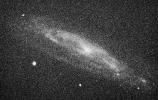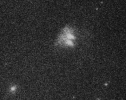 |
 |
 |
 |
| NGC 4192 | NGC 4216 | Arp 220 | NGC 4800 |
Galaxies were not recognized as a distinct kind of nebular object until the late 19th century, when visual spectroscopy (Huggins) of the Andromeda spiral (M31) showed a continuous spectrum. Though a clear naked-eye object, M31 had only rarely appeared in pre-telescopic depictions (except a description by one Al-Sufi in the tenth century). Distinct structure was reported by William Parsons, 3rd Earl of Rosse, whose 72-inch speculum-metal reflector showed clear spiral features in some bright nebulae such as M33, M51, and M101. This had previously been unseen because (1) speculum mirrors are less reflective than aluminum or silver on glass, so very large mirrors were required, (2) it's much easier to see something you already know is there. Photography turned up myriads of such spiral nebulae, particularly with work around 1900 by Keeler and Curtis with the 36" Crossley reflector at Lick Observatory. Early (visual) spectroscopy showed only that their spectra lack emission lines, and therefore must be continuous (giving the name "white nebulae). Speculation centered around the possibilities either that these were independent systems of stars (dating back to Kant), or that they were planetary systems in formation (as in Laplace's ideas). With hindsight, their early study is often described as the choice between these possibilities. The 1885 supernova in Andromeda added to the confusion, since it was clearly too bright to be a nova at extragalactic distances (supernovae being, of course, then unknown). To give some idea of the kinds of pictures that were available, here are some sample Crossley photographs of galaxies (being of much later vintage; I'm not old as I look to most grad students):
 |
 |
 |
 |
| NGC 4192 | NGC 4216 | Arp 220 | NGC 4800 |
V.M. Slipher at Lowell obtained heroic spectra of a few galaxies around 1910, showing large radial velocities (the greatest then known). In the Shapley-Curtis "Great Debate" of 1920, H.D. Curtis argued convincingly (for some of the wrong reasons) that the spirals are extragalactic "island universes" like the Milky Way. While the "debate" was clouded by confusion about the galactic and extragalactic distance scale, some of Curtis' points were quite correct:
Meanwhile study of the Magellanic Clouds (by Henrietta Leavitt and Annie Cannon) laid a basis for measuring galaxy distances, via the period-luminosity relation for pulsating Cepheid variables. Using the 100" reflector on Mt. Wilson, Edwin Hubble found Cepheids in what are now known as Local Group galaxies - M31, M33, IC 1613 - and established them as so distant that they must be separate systems. This history is all spelled out in Man Discovers the Galaxies by Berendzen, Hart, and Seeley (Science History Pub. 1976).
Hubble's results on Cepheids appeared in ApJ 62, 409 (1925) for NGC 6822; ApJ 63, 236 (1926) for M33; and ApJ 69, 103 (1929) for M31. An interesting issue in the history of science appears in contrasting these results to the contradictory conclusions reached by Adriaan van Maanen, also working at Mt. Wilson, who reported astrometric detection of rotation for several spirals such as M101 and M33. Such detection would require that these objects be quite nearby. Remeasurement of the plates has confirmed no such effect, and van Maanen followed all the rules for good practice in eliminating subjective measurement effects. Later work has failed to show where he might have gone wrong - is this a tribute to the power of subconscious suggestion, or what?
Last changes: 8/2006 © 2000-2006